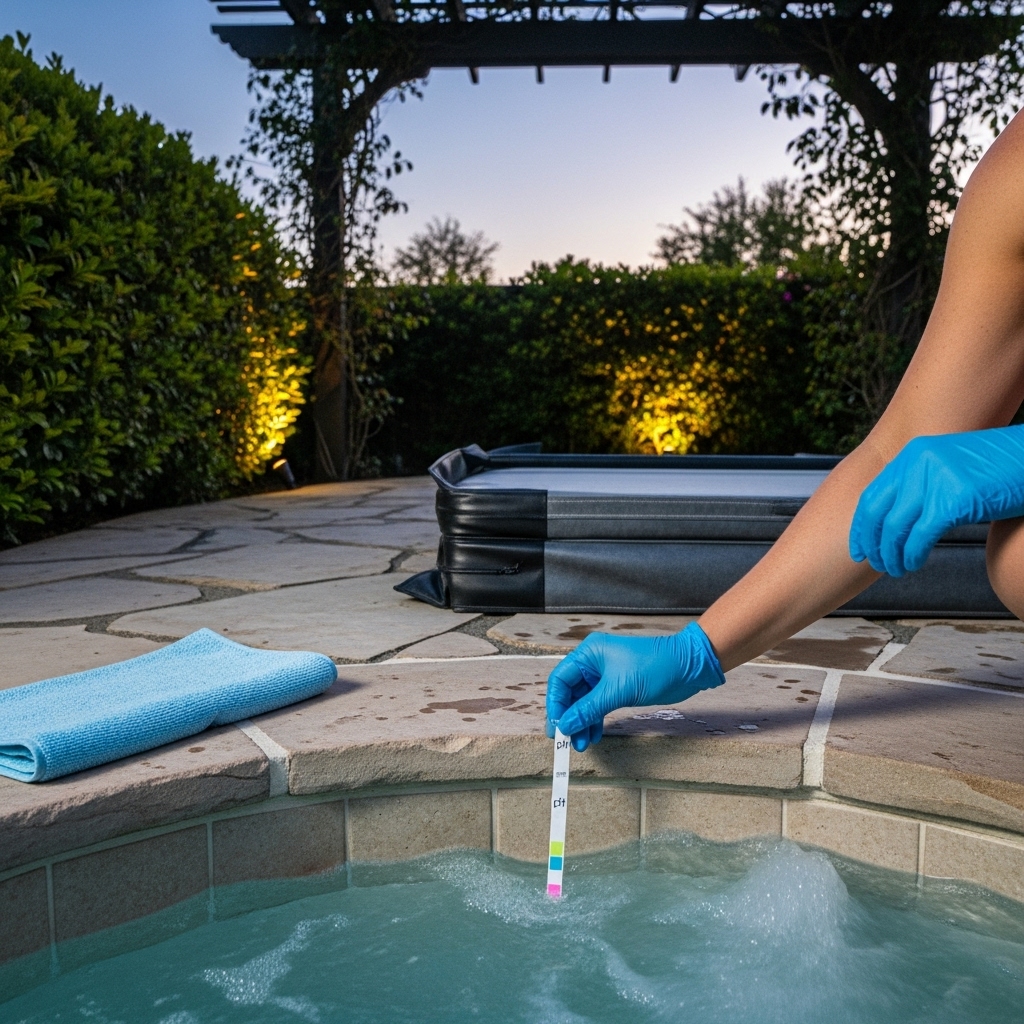Maintaining a hot tub in Woodland Hills is part science, part art, and entirely shaped by the rhythms of our Valley neighborhoods. If you’ve ever noticed a faint layer of dust after a windy afternoon or watched a trail of jacaranda petals float across the water in late spring, you’ve already seen how place influences care. A dependable routine turns those local quirks into predictable touchpoints. Whether your spa sits under a pergola off Ventura Boulevard or nestles in a leafy corner near Calabasas, you can keep it clear, comfortable, and always ready for a soak with a handful of steady habits—and a willingness to learn your spa’s unique language. For many homeowners, an early boost from trusted hot tub maintenance guidance makes the difference between trial-and-error and day-one confidence.
The first principle of successful maintenance is to think holistically. The water, the equipment, the cover, and your usage patterns form a single ecosystem. When one element is tuned well, it eases the workload on the others. Balanced water supports sanitizer efficiency. Clean filters lower strain on pumps and keep jets lively. A snug, healthy cover preserves heat, fends off debris, and creates the stable environment your spa needs between soaks. Understanding how these pieces work together simplifies everything else you do.
Start With the Water
Water chemistry is the foundation. If you’ve just filled your spa or it’s been a while since a refresh, take an unhurried approach to balancing. Test pH and alkalinity first, then confirm sanitizer levels. The Woodland Hills tap generally runs on the harder side, which means calcium and alkalinity deserve attention during those first hours after a refill. Once the foundation is set, your sanitizer can do its job efficiently, and small adjustments keep things steady. Over time, you’ll notice your spa’s tendencies. If you enjoy long jet cycles most evenings, aeration may nudge pH upward. If the spa sees frequent weekend use, plan for slightly more sanitizer demand and include a routine oxidation treatment to restore that crisp sparkle.
Clarity is the visible sign that your chemistry is in harmony, but your senses are partners in this. Clean, balanced water has a neutral scent and a silky feel. If the water’s aroma changes or the surface starts to look less glassy, tests will usually confirm what you’re sensing: a sanitizer that needs a boost, a pH that has drifted, or filters asking for a rinse. Responding early with gentle corrections prevents bigger swings later. Think of it like steering on a curving canyon road: small, frequent inputs keep you centered.
Respect the Filters
Filters are quietly doing the heavy lifting every hour of the day. In Woodland Hills, the combination of backyard living and occasional wind events means those pleats catch more than you expect—fine dust, tiny petals, the whisper of leaves. Make filter care a ritual. A quick rinse on a predictable schedule keeps water moving freely and takes pressure off the circulation system. When you plan a deeper clean, give yourself time to do it right and let the filters dry before reinstalling if you rotate sets; drying helps the material keep its shape and function. The payoff is immediate: clearer water, calmer pumps, and jets with the oomph you want after a long day.
Filters also tell you stories. If the pleats look matted or discolored in specific areas, it might reflect how water flows through the spa, or it might point to a buildup of oils after a weekend of entertaining. Use these cues to adjust your habits. Encourage a quick rinse-off before soaking, keep lotions off skin just before a soak, and consider a short post-gathering routine that includes a filter check and an oxidation treatment. Over months, these small choices become second nature and maintain a baseline of clarity that never feels like work.
Make Friends With Your Cover
A good cover is as important as any component in your spa. It is the gatekeeper for heat, debris, and evaporation, and in Woodland Hills, it faces everything from summer sun to winter breezes. Treat the cover kindly. Keep it clean with gentle products suited for the material, condition it as recommended, and never drag sharp objects across it. If your cover starts to feel heavier or you notice steam escaping around the edges, take that as a sign to inspect seals and stitching. A cover lift is a game-changer; when opening and closing the spa is effortless, everyone becomes more diligent about keeping it closed between soaks.
Placement matters, too. If your spa bakes under afternoon sun, find ways to provide shade that doesn’t trap heat—pergolas, umbrellas, or smart landscaping can all help. On breezy properties, a hedge or fence can serve as a windbreak, reducing evaporation and keeping airborne debris to a minimum. These environmental adjustments reduce the day-to-day demands on the cover and ease your overall maintenance routine.
Build a Weekly Routine That Fits Your Life
In practice, maintenance becomes easy when it piggybacks on routines you already have. Pick a specific day for a weekly check. Bring your test kit, give the filters a quick rinse, wipe the waterline, and listen to the spa run for a minute or two. This small ritual—done consistently—catches drift before it becomes a problem. If the week has been particularly social or windy, add a midweek moment: skim, test, and adjust. These short, predictable sessions prevent any single task from ballooning into a project and keep your spa ready for spur-of-the-moment soaks.
Seasonal pivots are natural times to add a milestone task. In spring, when pollen has had its main say, consider a deeper filter clean and a thorough wipe of the shell and pillows. In fall, after the first Santa Ana episode, do the same. In summer, focus on cover care and shade. In winter, confirm the cover’s seal and the comfort of your temperature setpoint. Align these with your calendar: before a holiday hosting run, ahead of summer BBQ season, or after a stretch away from home.
Sanitizer Strategy and Shock Moments
Sanitizer is your daily guardian. You want it steady enough that the water remains hygienic without becoming harsh. When usage spikes—guests, celebrations, school breaks—anticipate a small bump in demand and plan for a post-event oxidation treatment. This clears cloudy tendencies and lifts the load off your sanitizer, helping it return to its regular, gentle rhythm. Remember that balanced pH and alkalinity are what let sanitizer work efficiently; when those drift, sanitizer appears to “work harder” without accomplishing more. Keep the foundation steady, and your sanitizer can do its job with minimal drama.
If you’re new to spa care, you might be tempted to chase numbers. Resist the urge. Use test results as guides and pair them with observation. Over weeks, you’ll see how your spa behaves: perhaps your pH rises predictably after long jet cycles, or maybe your alkalinity drifts after a refill in ways that call for a deliberate adjustment. Routines that respond to real patterns keep maintenance light and effective.
Drain, Refill, and Reset
Every spa eventually reaches a point where the water feels tired—more effort, less reward. That’s your cue for a fresh start. Choose a moment that fits your calendar and the season. Give the filters a deep clean or swap to your alternate set. Refill thoughtfully, remembering that our local water’s hardness will influence how you balance. Once refilled, take your time bringing the water into harmony. When you get this right, everything that follows is easier: sanitizer behaves, clarity returns, and your weekly routine feels like a breeze again.
Use the reset as an opportunity to check the whole system. Inspect jets, clean the shell, refresh pillows, and condition the cover if recommended. A few extra minutes here pay dividends in months of hassle-free enjoyment. If you’re ever unsure about a reading or how the water feels, don’t hesitate to ask for help. A quick conversation can save hours of tinkering and set you back on the easiest path.
Match Maintenance to Your Woodland Hills Microclimate
From Oak Park neighborhoods that see more breeze to sheltered pockets near the foothills, microclimates matter. If you regularly experience dusty afternoons, you’ll favor more frequent filter attention and skimming. If your yard is lush with plants, watch for small organic loads—petals, pollen—that challenge clarity. If you’re in a sun-drenched spot, put more energy into cover care and shade. Align your routine with these realities, and the spa will reward you with stability.
One of the joys of Woodland Hills is evening soaking after hot days. To keep that experience perfect, encourage a quick rinse before family or guests hop in after time outdoors. Not only does it maintain water quality, it also makes the whole environment feel spa-like and intentional. Small rituals elevate the experience and reduce maintenance simultaneously.
Knowing When to Call in Backup
Even the most attentive owners occasionally benefit from expert eyes—especially during seasonal pivots, after a long stretch of entertaining, or when travel crowds the calendar. Strategic check-ins compress the learning curve and offer reassurance that your spa is operating at its best. If you prefer to handle the weekly rhythm yourself, this is a comfortable compromise: you keep the simple, satisfying parts and get help with the deeper refreshes. Midyear is a nice moment to seek tailored advice on hot tub maintenance, fine-tune your routine, and reset anything that’s drifted.
Listen, Learn, and Enjoy
Ultimately, good maintenance is attentive rather than intensive. The spa will tell you what it needs, and you’ll get better at hearing it. Changes in sound, feel, or scent are the spa’s language. If jets lose vigor, look to the filters first. If water loses its inviting sheen, check sanitizer and balance. If the cover feels heavier, inspect for moisture ingress and treat it kindly. These cues, interpreted calmly, keep maintenance in the realm of easy habits and let you spend most of your time enjoying the spa—not managing it.
How often should I test my water?
Test weekly at minimum, and add a quick check after heavy use, wind events, or refills. Over time, your spa’s patterns will guide you to the right cadence for your household.
What’s the best way to handle wind-blown dust and pollen?
Plan a short routine after gusty days: skim, run the jets, rinse filters, and confirm sanitizer. Addressing debris promptly prevents murkiness and keeps the water feeling fresh.
How do I know it’s time to change the water?
When it becomes harder to maintain balance, clarity takes more work, or the water feels “tired,” it’s time for a reset. Align the change with your schedule so you can give the refill your full attention.
Can I maintain my spa if I travel often?
Yes. Balance the water and clean filters before you go, secure the cover, and test on your return with gentle corrections as needed. A well-prepared spa rides out short trips without trouble.
Do I need professional help?
Many Woodland Hills owners enjoy the weekly routine and bring in help for seasonal refreshes or special situations. Choose the blend that keeps your spa reliable and stress-free.
If you’d like a steady routine, crystal-clear water, and peace of mind all year in Woodland Hills, now is the perfect time to get personalized guidance or schedule a seasonal tune-up. Reach out for trusted hot tub maintenance and enjoy a spa that’s always ready when you are.

